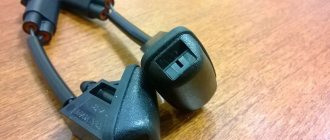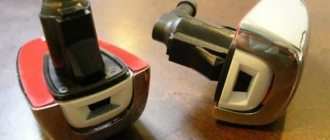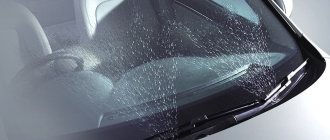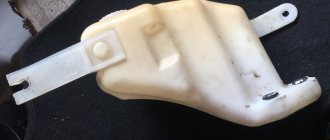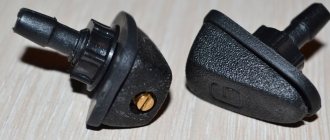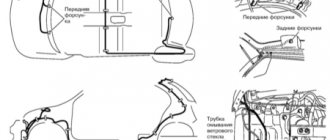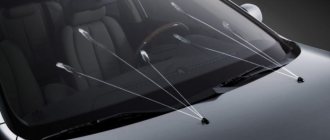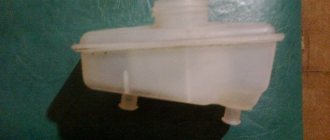The VAZ 2114 windshield washer fuse is necessary to protect the electrical wiring from ignition when an increased load or short circuit occurs. To determine where the VAZ 2114 windshield washer fuse is located, you should find out what type of mounting block is installed on the car. Depending on the year of manufacture of the VAZ 2114, the design of the fuse box is different.
Windshield washer device
The washer unit consists of:
- tank;
- pump;
- hoses for water supply;
- water spray nozzles.
The most optimal location of the water nozzles is in a position in which the jet hits the middle of the windshield.
Washer pump design:
- motor;
- impellers with blades;
- brushes.
When a motor fails, it is usually not repaired, it is simply replaced. Usually there are problems with the injectors.
New sample block
On more modern models, the VAZ 2114 washer motor fuse is located 7th from top to bottom in the left column. The maximum power of the power element is 30 amperes. The fuse for the VAZ 2114 washer protects several circuits simultaneously:
- Heater.
- Electric motors for headlight cleaners.
- Cigarette lighter.
- Illuminated glove compartment.
- Heated rear window relay.
A person who does not have specialized education will be able to detect the failure of a fuse. If a malfunction occurs, all consumers whose circuit is protected by this fusible element will stop working.
Washer reservoir location
As it turned out, a lot of drivers, especially women, do not know where the washer reservoir is located and how it works. If you open the hood of a car, there are models where different barrels are located next to each other, and sometimes in places opposite from the engine, but you need to figure out exactly which reservoir for washer fluid.
In some cars, the anti-freeze reservoir is located to the left of the engine, and in some - to the right. But, in most brands and models of cars, the location is on the right. Same with the fuse box, some on the left, some on the right.
Washer fuse location
In different cars, the fuse blocks and the fuses themselves are located in different orders; there is no single standard so that the block is, for example, on the right and there is a certain order of which fuse is responsible for what. Find out the location of the block and a specific fuse, for example, when replacing the cigarette lighter fuse. Therefore, we will consider for specific brands and models of cars in the photo.
On a VW Jetta 6 (Volkswagen Jetta 6), the washer fuse is located in the engine compartment, to the right of the engine.
Location of the washer fuse in the block of the VAZ 2110. The block itself is located in the passenger compartment on the driver's side. The fuse responsible for the operation of the washer is number 9 (second from the right from the top).
Location of washer fuse Wolksvagen Passat B7
Washer: breakdowns
Signs of a broken washer system are simple. This:
- if the motor works, but the liquid does not splash on the windows;
- if when you turn on the washer lever, no reaction occurs (the motor does not hum).
Problems with a running motor are called mechanical. Problems with a non-working motor (pump) are electrical.
Let's look at what specific breakdowns occur in the mechanical part:
- The fluid in the washer reservoir and supply hoses has frozen. To repair in this case, you need to put the car in a warm garage, start the engine and wait until the ice in the barrel melts.
- The hose has become disconnected. There are cuts at the connection points on the hoses, cut off part of the hose until the cracks are removed and connect tightly with a clamp.
- The washer fluid has run out. Top up. In the cold season - anti-freeze. In summer you can have water.
- Partial pump failure. It happens that the pump shaft has turned. At the same time, it is working, the noise of the pump is heard, but it cannot pump liquid. It can be solved by replacing the failed mechanism.
- The hose is cracked or bent. Replace if cut. Straighten it and make sure it is not pinched 90 degrees.
- The holes in the water spray nozzles are clogged. Clean or install new ones.
Types of electrical breakdowns and methods for eliminating them:
- The fuse has blown. This is the most common reason for the failure of not only the windshield washer system and other windows, but also the rear window heater of the VAZ 2107. The issue is resolved by replacing the fuse. But here a difficulty arises: where is the fuse for the windshield washer reservoir located? To find out, you need to download the circuit diagram for a given make and model of car and, having found the one that is responsible for this, remove the burnt one and install a new one. The old-fashioned method (instead of a fuse, use a piece of wire or put a coin) in this case can be used, for example, to get home in rainy weather. If it shorts, since the fuse is no longer present, the motor will burn out.
- The motor connection terminals have oxidized. They often oxidize, especially if there are compounds of aluminum and copper. Solved by cleaning or replacing the terminals.
- The lever for turning on/off the supply of liquid to the glass is out of order. The plug may have come loose. Needs replacement or repair.
Useful tips
Although the car windshield washer system is quite simple, breakdowns that occur for one reason or another cannot be ruled out.
It is important to understand that failure of individual system components occurs both in summer and winter. To avoid premature washer failures at any time of the year, you should always adhere to two rules:
To avoid premature washer failures at any time of the year, you should always adhere to two rules:
- use a special liquid;
- do not overload the washer motor;
If we consider the issue of liquid separately, in the summer you can use both summer and winter washer fluid. At the same time, it is a mistake to believe that liquid is better for winter. On the one hand, this option is noticeably more expensive, but this does not mean that this liquid is better.
In other words, it is not advisable to pour anti-freeze in the summer. Winter liquids do not have any special properties compared to summer liquids in terms of the quality of cleaning the glass itself. Their main difference is that summer washers freeze in cold weather, while winter washers do not.
It turns out that if in summer you can use any liquid, in winter you need to pour what is suitable for the season (winter washer fluid). Also, the winter washer fluid used must have the required properties (taking into account temperature fluctuations in a particular region).
For example, anti-freeze down to -5 degrees will not be suitable if severe frosts are expected. You have to purchase compounds down to -10, -15, -25 degrees, etc.
At the same time, the price of the washer fluid directly depends on frost resistance. In fact, anti-freeze -5 will cost more than summer liquid, but noticeably cheaper than an analogue designed for use at temperatures of -20, -25, etc. These are the most relevant recommendations for winter.
As for summer, you should not try to save money and fill the washer with regular tap water. At a minimum, the filters will become dirty. In the worst case scenario, clogged washer nozzles will have to be replaced. In some situations, it may even be necessary to replace the washer motor, which cannot cope with heavy loads.
By the way, about loads. If the fluid is poorly pumped through the system, the filters and nozzles are dirty, the tubes are crushed or broken, the fluid level in the tank is constantly low, then the motor experiences increased loads. In such conditions, it is more difficult for the system to pump liquid.
Also, if the driver turns on the washer for a long time (10 seconds or more), the motor and the entire pump mechanism also wear out actively. As practice shows, when paired with high-quality brushes, it is enough to apply liquid to the glass in short pulses of 2-3 seconds. If the liquid is not supplied in the required volume, it is necessary to diagnose and clean all components of the windshield washer system.
Let us also add that for cars that are operated in severe frost conditions, it is not superfluous to have heated washer fluid, heated wipers, heated washer nozzles, etc.
Such solutions make it possible to heat the washer fluid reservoir, prevent freezing of the liquid in the nozzles themselves, etc. The main thing is not to apply heated liquid onto glass that is too cold. The reason is that glass can crack as a result of a sharp temperature change.
Improvement for windshield cleaning
Refinement and improvement of the windshield, windshield and rear window washers significantly improve operation.
Improving the washer's performance is as follows: you need to buy a new reservoir with the ability to install one or more motors. There are tanks with recesses for two motors. Also, according to the material, there are soft and hard plastics, hard ones last longer and withstand ice (if the water or anti-freeze is frozen). Some people connect one motor to one injector. At the same time, the flow rate increases, but the pressure increases. In general, watch the video on modifying the washer.
Windshield washer: where is it located and how to fix it?
Hello! I can't find where the windshield washer fuse is located. Please tell me. (Igor Vasiliev)
Good afternoon. Thank you for your question, we will answer it in detail now.
There are many breakdowns due to which the glass washer does not function, and for many drivers this is a real problem. Although in most cases it is enough just to know where the fuse for the windshield washer is located in order to restore the system's functionality. But the problem may lie elsewhere. And in order to make it easier to find a breakdown and fix it, we decided to divide them into 2 types, in particular those associated with the electrical part, and those associated with the mechanical part.
Electrical
Problems with electrical systems are rare. You can fix them yourself, but if in doubt, contact an experienced mechanic.
- The first place among the problems is the failure of the fuse. It’s easy to fix the problem - re-read the car’s operating instructions and use the symbols to find the required fuse and replace it with a new one.
- Another reason is that the washer motor does not work. The reason is oxidation of the terminals or their falling off. To eliminate the malfunction, you need to clean the contacts and reconnect the components if necessary.
- It also happens that the washer switch on the steering wheel does not work. You can check this using a multimeter. Connect the device to the motor terminals and check the voltage. If it is in order, but the mechanism does not work, most likely the switch is to blame. But a problem in the electrical wiring or lack of closure of the device relay cannot be ruled out. If it doesn’t work after replacing it yourself, you can’t do it without an experienced technician.
How is it arranged?
The washer system consists of:
- tank (located on the right in the photo);
- pump (motor);
- water supply hoses;
- nozzles that directly supply water to the windshield of the car.
Set of nozzles
Nozzles are installed so that the jet is directed to the middle part of the glass. A pump (motor) is necessary for direct water supply. It should be noted that in some modifications, water is supplied simultaneously to the headlights and also to the rear window.
Pump motor
The pump itself is a small motor consisting of:
This part is significantly different for different modifications. But there is only one purpose - to supply washer fluid. In most cases, the malfunction lies either in the tank itself or in the injectors. Depending on the modification of the car, these elements need to be replaced or simply repaired. But if the motor breaks down, it will most likely need to be replaced.
Connection diagram of the mounting block:
P1 — relay for turning on the heated rear window; P2 - relay for turning on the headlight cleaners and washer; P3 - relay for turning on sound signals; P4 - relay for switching on the electric motor of the engine cooling system fan; P5 - headlight high beam relay; P6 - low beam headlight relay; A - the order of conditional numbering of plugs in the mounting block blocks. The outer number with the letter “Ш” in the plug designation is the block number, and the inner number is the conventional number of the plug. The plugs of the blocks without color marking are conventionally shown in brown
Mounting block (cover removed): 1 — relay for turning on the heated rear window (P1); 2 — relay for turning on the headlight cleaners and washer (P2); 3 - relay for turning on sound signals (P3); 4 — relay for switching on the electric motor of the engine cooling system fan (P4); 5 - spare fuse; 6 — relay for turning on the high beam headlights (P5); 7 — relay for low beam headlights (P6); 8 - fuse
Where is?
Everyone knows the situation when the water in the windshield washer reservoir runs out, but in order to top it up, you need to at least have an idea where it is. And this is a problem for some, because when we open the hood, we see several tanks at once, and it’s hard to figure out where exactly the one we need is located.
The tank we need is usually located to the right of the battery, and next to it is the block that contains the fuse that is responsible for the windshield washer system.
What to do if the windshield washer does not spray
A malfunction of the windshield washer most often occurs during the winter period of vehicle operation. At the same time, a non-functioning washer system during heavy traffic on a frozen, polluted road can lead to a complete loss of visibility of the road situation.
Therefore, when going on a winter trip, it is necessary to check the functionality of the washer and the degree of filling of the reservoir with washer fluid.
Why is the windshield washer not working?
The causes of windshield washer malfunction can be divided into:
The physical reasons are based on the freezing of the liquid poured into the washer system. It is incorrect to believe that water freezes when the ambient temperature is below zero degrees Celsius.
Water can freeze even at positive ambient temperatures. While the car is moving, the thin tubes of the washer system and the nozzle are blown by air currents. At high humidity, due to physical processes, the tube is cooled, blown by high-speed air flows. If the ambient temperature is slightly positive, the temperature of the liquid in the tube (nozzle) may drop to minus values.
Therefore, it is important to promptly (when night temperatures drop below plus 2-5 degrees Celsius) replace the water in the washer system with non-freezing liquid, and expel the remaining water by briefly turning on the washer.
There is a lot of counterfeit on the Russian market. It’s a good idea to check the quality of the washer fluid (washer fluid) by placing it in a small plastic bottle in the freezer. The temperature in the freezer is approximately minus 18 degrees Celsius. There are times when the washer temperature is “-30 degrees”, and the liquid freezes in the freezer.
Washer failure can occur when water gets into the windshield nozzle (sprinkler). It is located at a positive angle to the horizon, therefore, if non-freezing liquid leaves it (this is possible due to insufficient tightness of the tubes and wear of the pump), rainwater and condensation after fog enter the free cavity. A microscopic drop is enough to block the washer fluid supply channel when frozen, and the system will be inoperable.
Video - how to defrost ice in the washer reservoir (some useful tips):
Physical malfunctions include loss of tightness of the membrane in the pump. Most electric washer pumps are of the membrane type. When the membrane wears out or is ruptured by frozen water, the pump drive remains operational, the pump “buzzes,” but does not pump liquid.
Another physical malfunction is damage to the integrity of the washer tubes.
Electrical faults include:
- pump electric drive malfunction;
- damage to electrical wiring;
- failure of the fuses servicing the pump (often when the pump freezes);
- Malfunction of the electronic body control unit.
If the windshield washer does not work - sequence of actions
Pump check
Determining the cause of a windshield washer malfunction begins with checking the functionality of the pump.
To do this, with the ignition on, briefly press the corresponding switch on the steering console. If the brushes begin to work and the pump drive does not make characteristic sounds (you will have to resort to the help of an assistant), the pump or electrical wiring may be faulty.
If the brushes also do not move, the fuse is most likely blown.
Checking the windshield washer fuse
The most important thing is to correctly determine which fuse is responsible for the windshield washer. It can be located either in the engine compartment fuse and relay box, or in the steering column (on the side of the dashboard).
To more accurately understand where the fuse for the windshield washer is located, you can use the diagram in the operating manual or find it in a search engine by creating the query “fuse location diagram + car make, year of manufacture.” If the fuse box has a decoding in English, it is designated by the word “washer”.
If the body control unit is faulty (this is the most serious fault), several fuses may be responsible for the washer's functionality.
A good resource that helps you understand which fuse is responsible for the windshield washer and where it is located in cars of various brands and models - avtoblokrele.ru.
You can verify that the washer pump is working properly by directly connecting it to the battery terminals. This can be done without removing it from the tank, using temporary conductors, by disconnecting the chip.
If the pump “buzzes” and fluid does not spray out, you need to disconnect the outlet tube from the pump. If in this case, even when the tank is filled, liquid does not flow, the membrane may be faulty or the channels in the pump are clogged.
The pump cannot be repaired, its cost is small (about 1,500 rubles, you can get it from other car models).
Video - how to change the windshield washer pump on a Volkswagen Bora:
Checking pipes and injectors
If the pump is operational and liquid does not spray out of the nozzles, it is necessary to check the integrity of the tubes and the absence of clogging and freezing of the nozzle. The easiest way to do this is by blowing.
If the nozzle is frozen, you can defrost it by placing a warm, wet cloth on it. It can be heated on a hot radiator of the engine cooling system. Minor freezing can be eliminated by sprinkling the outlet hole with a pinch of salt.
Diagram of wires and fuses for the car VAZ 2114, VAZ 2115, VAZ 2113, Lada Samara 2
Electrical diagram of Lada Samara 2 cars (left half): 1 – headlights; 2 – fog lights; 3 – air temperature sensor; 4 – electric motor of the engine cooling system fan; 5 – blocks connected to the wiring harness of the ignition system; 6 – engine compartment lamp switch; 7 – block for connection to a single-wire type audio signal; 8 – sound signal; 9 – washer fluid level sensor; 10 – front brake pad wear sensors; 11 – oil level sensor; 12 – generator; 13 – engine compartment lamp; 14 – coolant temperature indicator sensor; 15 – starter; 16 – battery; 17 – relay for turning on fog lights; 18 – coolant level sensor; 19 – brake fluid level sensor; 20 – reverse light switch; 21 – windshield wiper gearmotor; 22 – oil pressure warning lamp sensor; 23 – block for connecting to the rear window washer electric motor; 24 – windshield washer electric motor; 25 – instrument cluster; 26 – mounting block. Conventional numbering of plugs in blocks: A - block headlights; B — electric fuel pump block; C — blocks of the mounting block, ignition switch, windshield wiper gearmotor; D — interior lamp
Prevention measures
In order to avoid sudden problems with the operation of the windshield washer system, you must:
- promptly refill the washer reservoir with antifreeze liquid and remove water from the system;
- check the quality of the antifreeze in the freezer; it is better to buy liquid at a gas station;
- remove the chip from the pump and inject silicone grease into the contact area, it pushes water out of the contact area, preventing corrosion;
- if the tubes crack, replace them with serviceable ones, you can take silicone tubes from an IV (sold at any pharmacy);
- When operating a vehicle at temperatures below minus 25 degrees Celsius, it is recommended to install heated injectors.
Read the article about how to decarbonize oil scraper rings without disassembling the engine, and in what cases this has to be done.
Do I need to charge a new battery immediately after purchasing it in a store?
Video - searching for the cause of a windshield washer malfunction on a VAZ 2112:
Additional heating system
One of the current options for winter is the installation of an additional heating system for the windshield washer reservoir and nozzles. The car owner can forget about problems with liquid freezing or icing of pipes.
Equipment manufacturers produce standard-shaped injectors with built-in heating. Resistors are used to maintain temperature and prevent icing. The power supply passes through the resistance, as a result of which heat is generated, which prevents the element from freezing. The liquid supply tubes are specially insulated, and electric heaters can be used to heat the tank.
A windshield washer is a must-have device, without which it is difficult to imagine a car. It allows you to increase the safety and comfort of driving a vehicle.
The glass washer on the VAZ does not work
The front window washer, like the windshield wiper, is a very important device that directly affects traffic safety. Therefore, it is important to know about its malfunctions and be able to quickly eliminate them.
To understand why a windshield washer may not work, you need to know how it works in general. The connection diagram for this device is simple: a wire runs from the fuse box to the steering column switch. When the switch is pressed (classic version), voltage is supplied through another wire to the washer pump, and the third wire connects this pump to ground. The pump is installed directly on the washer fluid reservoir and supplies this fluid through flexible tubes to the nozzles. Nozzles with one or more holes spray liquid onto the glass. Actually, that's the whole scheme.
Due to the simplicity of this system, its malfunctions are also primitive.
Windshield washer does not turn on
When you press the corresponding steering column switch from under the hood and you cannot hear the pump whirring, the first thing to do is check the fuse. Moreover, often this can be done instantly by simply turning on the windshield wiper. As a rule, the glass washer is connected to it through the same fuse, so if the wipers do not work, it means the fuse has blown. If the wipers on your car are on a separate fuse, then you need to directly verify the integrity of the fuse. It is also worth making sure that the fuse has reliable contact with its socket in the mounting block.
Replace the blown fuse with a new one of the same rating, and if the new one also burns out, then there is a short circuit in the car wiring. Moreover, if the fuse burns out when the washer is turned on, then the short circuit must be looked for in the pump power circuit.
If the fuse is intact, then you need to make sure that voltage is supplied to the washer pump. With the steering column switch in the appropriate position, check for voltage on both wires leading to the pump. One of them must have a “+”.
The absence of voltage indicates a faulty steering column switch or broken wires in the sections “fuse box - steering column switch” or “steering column switch - washer pump”.
If power is supplied to the pump normally, it is worth checking the ground. To do this, connect the “mass” wire of the washer (the one that is connected to the terminal marked on the pump body with the sign “—”) with the positive terminal of the battery through a control light
(.). If you just connect with a wire, a short circuit will occur !
“Control” in this case will be the consumer who will save you from the “short man”. If the light comes on, it means there is a ground and the pump needs to be replaced. The washer pump can burn out from old age or from a wedge of ice during a freeze. It often happens that the driver did not have time to replace the water with non-freezing liquid and the water froze. When the washer pump is turned on, its rotor becomes jammed with ice and the motor winding burns out.
The washer turns on, but the water does not spray
There are situations when the pump hums, but water does not flow to the glass. The most commonplace version of such a “malfunction” is a lack of fluid in the tank. But there are even more complex problems, for example, frozen injectors. In winter, snow and ice can stick to them; in the fall, water can flow inside the holes and freeze there.
Moreover, it must be taken into account that there is no return line in the washer system, so the pressing liquid, which has no outlet, can tear the tubes or “pull” them from the tee (the part that distributes water from one hose to two to the nozzles is located in the trapezoid area on most cars wipers). Therefore, if there is no water from the nozzles for a long time, there is no need to stubbornly keep the washer pump on. By the way, running the pump “dry” for a long time can also contribute to its failure.
Another explanation why the washer works, but water does not flow, is a rupture of the supply tubes or a broken tee. This happens extremely rarely and just during transitional times of the year, when water freezes in the pipes and ruptures them.
“Global” electrical causes not related to the washer
There are also more global reasons that are not directly related to the glass washer system, but can lead to the washer not working.
If after all the checks it turns out that everything is normal, but there’s no point, it’s worth “deepening into the problem” further. Check the voltage at the fuse socket. It may well turn out that the reason is inside the mounting block: for example, the current-carrying path has burned out or the contact has oxidized. The cause may also be the contact group of the ignition switch, if on your car it is part of the washer pump power supply system (you need to study the electrical diagram of a particular car).
It is worth saying that “global” reasons will certainly lead to the failure of other devices in the car. For example, the same wipers. Such deep and unobvious faults must be looked for on your own, only with the necessary knowledge and skills. If you have doubts about your own abilities, you should take the car to a specialized service for repairs.
Description for pre-restyling
Block under the hood
General photo - diagram
Description of fuses
| F1 | Not used |
| F2 | Not used |
| F3 (25) | Chains: fuel pump and ignition coils; main relay K5 of the engine management system |
| F4 (15) | Air conditioning compressor electromagnetic clutch circuit |
| F5 (40) | Power circuits: low speed cooling fan short circuit relay |
| F6 (60) | Circuits protected by fuses F9, F10, F28, F29, F30, F31, F32, F36 of mounting block 1 in the passenger compartment |
| F7 (60) | Circuits protected by fuses F13, F14, F15, F16, F17, F18, F19, F20, F24, F26, F27, F37, F38, F39 of the mounting block in the passenger compartment |
| F8 (60) | Circuits protected by fuses F1, F2, F3, F4, F5, F11, F12 of the mounting block in the passenger compartment |
| F9 (25) | Circuits under voltage in position S and A of the ignition key |
| F10 (80) | Power circuits of the interior electric heater relay |
| F11 (50) and F12 (25) | ABS control unit circuits |
Relay designation
- K1 - High speed cooling fan relay
- K2 - Air conditioner relay
- Short circuit - Low speed cooling fan relay
- K4 - Fuel pump and ignition coil relay
- K5 - Main relay of the engine control system
- K6 - Not used
- K7 - Fog lamp relay. If it is not there, then the PTFs are not installed.
- K8 - Heater fan relay
Other versions of this block.
Heated rear window does not work
In this case, you can download the full description here.
Block in the cabin
Located at the end of the dashboard on the driver's side behind the cover.
Scheme
Decoding
| F1 (20) | Chains: windshield wiper; tailgate glass heating relay coils |
| F2 (5) | Circuits: instrument cluster power supply; relay windings K4 of the fuel pump and ignition coils; the power supply to the engine control system ECU is from the ignition switch; |
| F3 (10) | Brake light circuits |
| F4 (10) | Chains: turn signal lamps; engine management system diagnostic connector (pin 1); immobilizer coils; switching block |
| F5 (5) | Rear gearbox electromagnetic clutch control circuit |
| F6 | Reserve |
| F7 | Reserve |
| F8 | Reserve |
| F9 (10) | Left headlight low beam circuit |
| F10 (10) | Right headlight low beam circuit |
| F11 (10) | Circuits: high beam lamps of the left headlight; high beam headlight indicator in the instrument cluster |
| F12 (10) | Right headlight high beam lamp circuit |
| F13 (30) | Rear door power window circuits |
| F14 (30) | Front door power window circuits |
| F15 (10) | ABS control unit circuit |
| F16 (15) | Driver and front passenger seat heating circuits |
| F17 (15) | Audio circuits |
| F18 (10) | Circuits: left side headlight lamps; left rear side light bulbs |
| F19 (10) | Circuits: side light bulbs of the right headlight; side light bulbs for the right rear light; license plate lamps; glove compartment lamps; Illumination of the instrument cluster and controls on the instrument panel, console and floor tunnel lining |
| F20 (7.5) | Rear fog lamp circuit |
| F21 (5) | Exterior mirror heating element circuits |
| F22 | Reserve |
| F23 | Reserve |
| F24 (5) | Power steering control circuit |
| F26 (5) | Airbag control unit circuit |
| F27 (20) | Chains: parking sensors; reversing lamps; windshield and tailgate glass washer |
| F28 (15) | Circuits: interior lamps; trunk lamps; backlight lamps for the head unit of sound reproduction |
| F29 (15) | Circuits: intermittent windshield wiper; turn signal switch; hazard switch; central locking control; buzzer; engine management system diagnostic connector |
| F30 (20) | Central lock chains |
| F31 (15) | Fog light circuit |
| F32 (30) | Heated tailgate glass relay power circuit |
| F33 | Reserve |
| F34 (15) | Rear gearbox electromagnetic clutch circuit |
| F35 | Reserve |
| F36 (30) | Heater fan relay K8 power circuit |
| F37 (5) | Electric drive circuits for exterior rear view mirrors |
| F38 (15) | Cigarette lighter renault duster; power supply to the head unit for sound reproduction from the ignition switch |
| F39 (10) | HVAC Motor Relay |
Separately, under the anti-theft device, along the dashboard beam, there can be a relay for an additional interior heater (1067 - 1068), and under the instrument panel a rear window heating relay (235).
Causes of washer malfunction
If the windshield washer does not work, it will not be difficult for an experienced driver to identify the cause of such a malfunction, and even a beginner, after familiarizing himself with the main failures in the cleaning system, will be able to eliminate them on his own.
Mechanical problems
The most important reason, as mentioned above, may be the lack of washer fluid; in this case, you just need to top it up. If it is present, but does not splash in the winter, then perhaps it is simply frozen. In this case, the problem can be solved in one of two ways:
- warming up the engine;
- bringing the car into a warm garage.
After the liquid has thawed, the system will begin to operate as usual, but it is better to drain the water from the tank after this and replace it with an “anti-freeze” one.
Other significant mechanical reasons why the windshield washer does not spray include the following factors.
- Clogged injectors . Their exit can be blocked by various debris: rust, dirt or small particles. To check the correctness of the guess, you need to stop the supply of working fluid to the nozzles; if this is the case, then the supply of “anti-freeze” will be normal. The solution to this problem lies in replacing the nozzles.
- Disconnecting the hose . It may simply fly off while driving on bumpy roads, and then the fluid supply will continue, but the headlight and windshield washer nozzle will remain dry. Sometimes this happens in cars in which the connecting fittings are located on the hood, then when it is closed, the hoses are squeezed. In any case, the deformed or torn tube must be replaced and returned to its place.
Electrical faults
After checking the fluid level, the cleanliness of the injectors and the hose leading to them, it may turn out that all this has nothing to do with it, then the issue is for the following reasons:
- Fuse blown . You will need to find the safety block and check the insert; it can be found using the attached diagram, which is usually printed on the cover or in the car’s operating instructions. After checking, if this is indeed the reason, then you need to replace the damaged part
- Motor failure . To establish the accuracy of your guess, you should connect a multimeter to the motor terminals and check the voltage when you turn on the washer. If the voltage indicator is normal, but the motor remains inoperative, then the problem lies with it. You can determine which motor has failed by elimination, by moving the pump terminals from the windshield to its rear counterpart.
- Washer switch malfunction . It is usually located on the steering wheel. If, after checking the voltage, it is missing, and replacing the motor with a new unit did not help, then it turns out that the windshield washer switch or relay is not working. Only an experienced auto electrician can accurately diagnose a breakdown.
- Oxidation of pump terminals . During operation, they can not only oxidize, but also completely fall off, which is why the motor stops pumping liquid. To return everything to working condition, you need to clean the oxidized terminals or replace them with new ones.
↑ Electronic relay 524.3747
The purifier has three operating modes, they are activated by the right steering column switch. Intermittent mode is provided by an electronic relay K2 type 524.3747 installed in the mounting block. This relay also turns on the wiper motor at low speed when the windshield washer is turned on. The relay must ensure that the electric motor is turned on with a frequency of 14±4 cycles per minute at a gearmotor shaft speed of at least 20 min -1, a temperature of 20±5°C and a supply voltage of 14±0.2 V.
When the cleaner operates at low speed in constant mode, the supply voltage is supplied to diametrically opposed brushes. When the cleaner operates at maximum speed, “+” power is supplied to the brush located on the side.
To relieve the load on the contacts of the ignition switch, the cleaner is connected through an additional relay K6 in the mounting block.
It is recommended to replace a faulty gearmotor with a new one (cleaning the commutator, limit switch contacts and replacing gears is possible). Bent levers are straightened. When the hinges wear out, they are replaced.
Do-it-yourself troubleshooting
The main reasons for the lack of washer fluid can be eliminated with your own hands.
Cleaning the injectors
Their replacement and cleaning occurs in the same way and it begins with the removal of these parts, the process is as follows:
- open the hood;
- make sure that they have plastic plugs; if they are present, they must be carefully removed;
- take a flat-head screwdriver and open their spring fasteners to remove the injectors.
Installation of new parts occurs in the reverse order.
To wash the injectors and free them from dirt, you should prepare a special cleaning solution of non-chlorinated water and vinegar, taken in equal proportions. The mixture is mixed well and then poured into the tank. After which you need to press the washer lever, even if the water does not reach the glass, it’s okay. So that the components of the solution have time to break down all the contaminants, you need to leave it in the cleaning system for 2 hours, and then press the lever again. After the dirty solution flows out of the nozzles, rinse the hoses with distilled water.
Replacing the motor
It is quite difficult to repair the motor yourself, so most often it is simply replaced.
Installation of a new device is carried out as follows:
- remove all liquid remaining in the tank from the tank;
- disconnect the contact between the battery and the pump;
- if necessary, you can dismantle the tank, but if manipulations can be carried out with a fixed device, then you don’t have to do this;
- remove the electric pump from the tank and unscrew all the hoses going to it, but just remember their location so that after repair they can all be returned to the correct places;
- connect a new pump to the system;
- screw all the tubes;
- connect the battery to the motor;
- pour liquid into the reservoir.
Check the operation of the motor by pressing the washer lever; if you hear a whirring sound from the pump, then everything went well.
Do-it-yourself modification and replacement of wipers
Which wipers are better is up to the car owner to decide. Those installed on the VAZ 2110, as well as on the UAZ, do their job well from the factory, but it can be modified with washers from other companies that are of higher quality. Many people are attracted to frameless brushes - this is a good option. They are compact in size and equipped with a special leash mechanism. True, they do not look very attractive on the VAZ 2110, since the fastener to the standard washer arm turns out to be massive. Therefore they need improvement.
Frameless car washers
To perform a replacement or modification, you must perform the following steps:
- First you need to disconnect the negative terminal on the battery.
- Then you need to tilt the mount towards you and remove the brush.
- If there is a decorative trim, it must be removed.
- By unscrewing the bolt, you can remove the old brush.
- Before replacing parts, be sure to check the dimensions of the new washer with the old one. It is advisable that the new one does not exceed the size of the old one by more than 2 cm.
- Installation of the new kit is carried out in the reverse order.
Sorry, there are no surveys available at this time. https://www.youtube.com/watch?v=Pg9cb6Fr3JI
conclusions
If the rear or windshield washer fails, any problem can be quickly resolved, the main thing is to find the cause of the malfunction. In case of problems with nozzles and their complete replacement, it is better to choose these fan-type parts; they wet the glass better. Problems with the integrity or partial deformation of connecting tubes are best solved by connecting new cords. To avoid the listed problems with the washer system, you should use non-chlorinated water in warm weather, and “anti-freeze” water in cold weather.
Sources:
https://autostuk.ru/gde-naxoditsya-predoxranitel-na-omyvatel-lobovogo-stekla.html https://avtozam.com/help/omyivatel-lobovogo-stekla/ https://voditeliauto.ru/poleznaya-informaciya /to-i-remont/omyvatel-lobovogo-stekla.html https://russia-avto.ru/remont/pochemu-ne-rabotaet/ne-rabotaet-omyvatel-stekla-na-vaz https://motorsguide.ru /system/omyvatel-lobovogo-stekla
